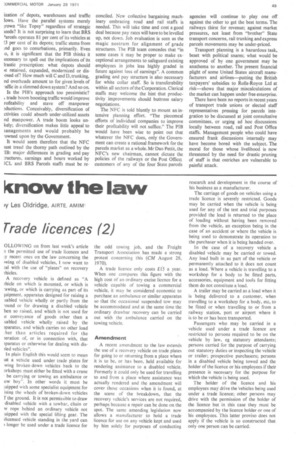know the law
Page 51

If you've noticed an error in this article please click here to report it so we can fix it.
ry Les Oldridge, AIRTE, AM111/11
rrade licences (2)
OLLOWING on from last week's article ri the permitted use of trade licences and ly recent ones on the law concerning the 'wing of disabled vehicles, I now want to :al with the use of "plates" on recovery
A recovery vehicle is defined as "A :hicle on which is mounted, or which is -awing, or which is carrying as part of its aiipment, apparatus designed for raising a sabled vehicle wholly or partly from the -ound or for drawing a disabled vehicle hen so raised, and which is not used for Le conveyance of goods other than a sabled vehicle wholly raised by the waratus, and which carries no other load :her than articles required for the )eration of, or in connection with, that )paratus or otherwise for dealing with dis)led vehicles".
In plain English this would seem to mean [at a vehicle used under trade plates for wing broken-down vehicles back to the orkshops must either be fitted with a crane
• be carrying or towing an ambulance or ow boy". In other words it must be tuipped with some specialist equipment for ising the wheels of broken-down vehicles I the ground. It is not permissible to draw disabled vehicle with a towbar, chain or w rope behind an ordinary vehicle not pipped with the special lifting gear. The 'licensed vehicle standing in the yard can longer be used under a trade licence for
the odd towing job, and the Freight Transport Association has made a strong protest concerning this (CM August 28, 1970).
A trade licence only costs £1:5 a year. When one compares this figure with the high cost of an ordinary excise licence for a vehicle capable of towing a commercial vehicle, it may he considered economic to purchase an ambulance or similar apparatus so that the occasional suspended tow may be accommodated and at the same time the ordinary drawbar recovery can be carried Out with the ambulance carried on the towing vehicle.
Amendment A recent amendment to the law extends the use of a recovery vehicle on trade plates for going to or returning from a place where it is to be, or has been, held available for rendering assistance to a disabled vehicle. Formerly it could only be used for travelling to and from a place where assistance was actually rendered and the amendment will cover those occasions when it is found, at the scene of the breakdown, that the recovery vehicle's services are not required, perhaps because a repair can be done on the spot. The same amending legislation now allows a manufacturer to hold a trade licence for use on any vehicle kept and used by him solely for purposes of conducting research and development in the course of his business as a manufacturer.
The carriage of goods on vehicles using a trade licence is severely restricted. Goods may be carried when the vehicle is being used for any of the test and trial purposes provided the load is returned to the place of loading without having been removed from the vehicle, an exception being in the case of an accident or where the vehicle is being used to demonstrate its operation to the purchaser when it is being handed over.
In the case of a recovery vehicle a disabled vehicle may be carried or towed. Any load built in as part of the vehicle or permanently attached to it does not count as a load. Where a vehicle is travelling to a workshop for a body to be fitted parts, accessories, equipment and tools for fitting them do not constitute a load.
A trailer may be carried as a load when it is 'being delivered to a customer, when travelling to a workshop for a body, etc, to be fitted or when travelling to or from a railway station, port or airport where it is to be or has been transported.
Passengers who may be carried in a vehicle used under a trade licence are restricted to persons required to be on the vehicle by law, eg statutory attendants; persons carried for the purpose of carrying out statutory duties or inspecting the vehicle or trailer; prospective purchasers; persons in a disabled vehicle being towed and the holder of the licence or his employees if their presence is necessary for the purpose for which the vehicle is being used.
The holder of the licence and his employees may drive the Vehicles being used under a trade licence; other persons may drive with the permission of the holder of the licence but in this case they must be accompanied by the licence holder or one of his employees. This latter proviso does not apply if the vehicle is so constructed that only one person can be carried..




























































































